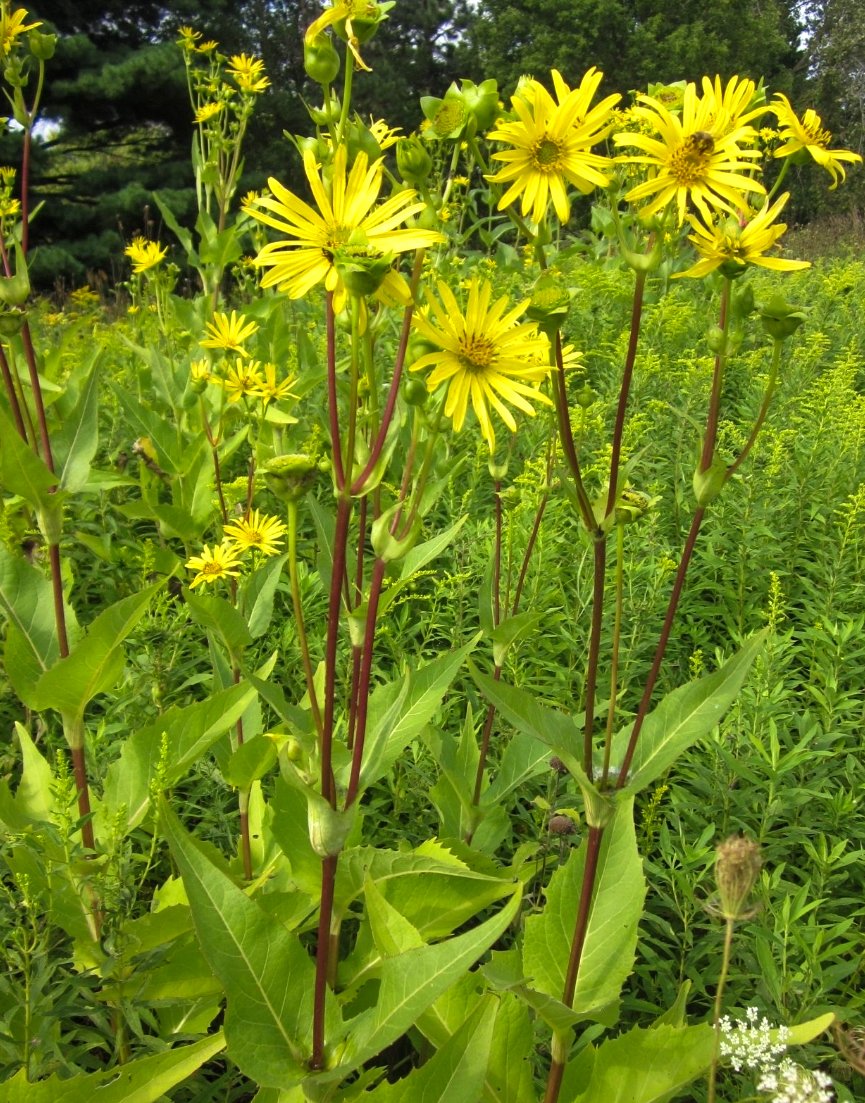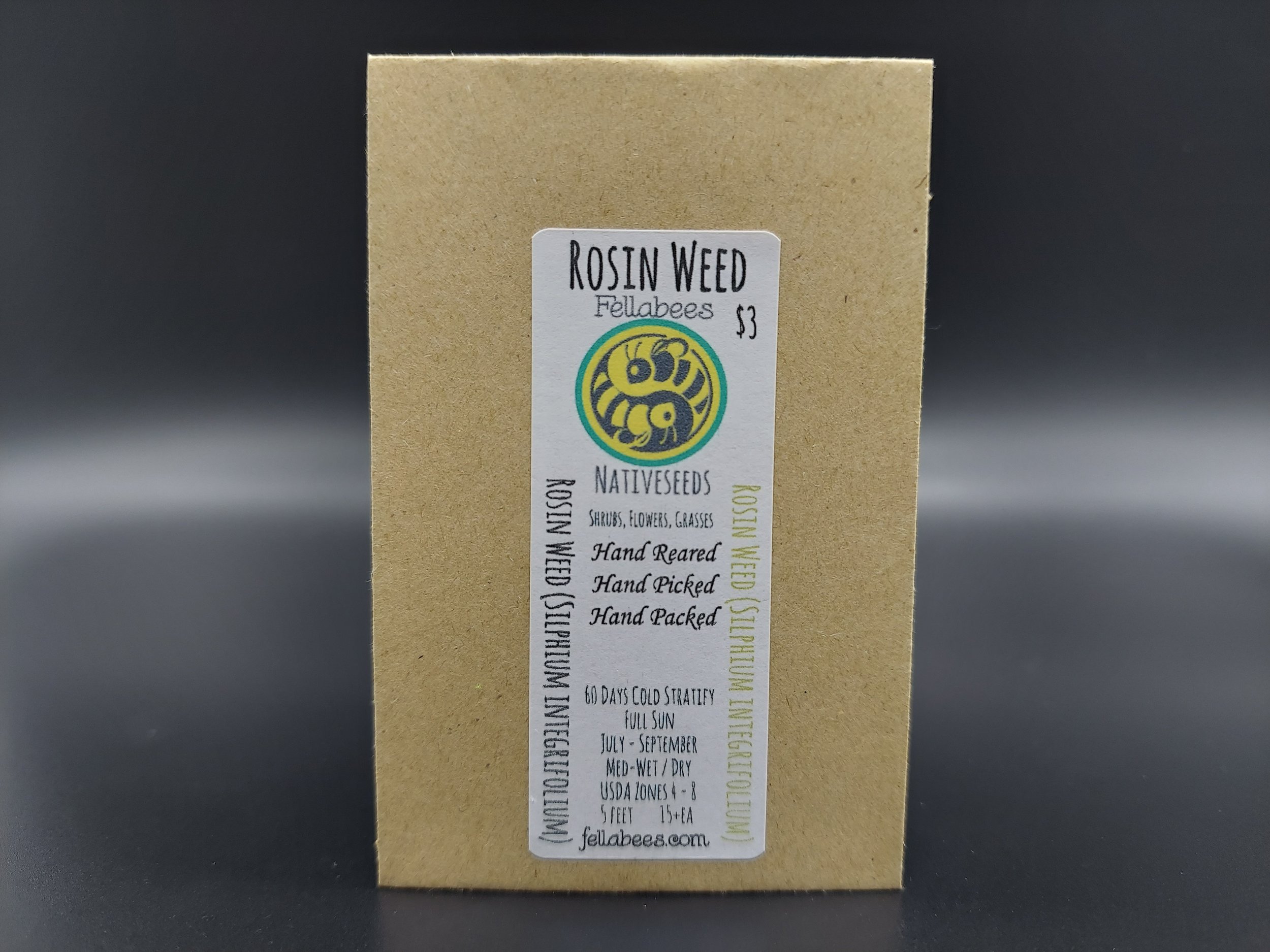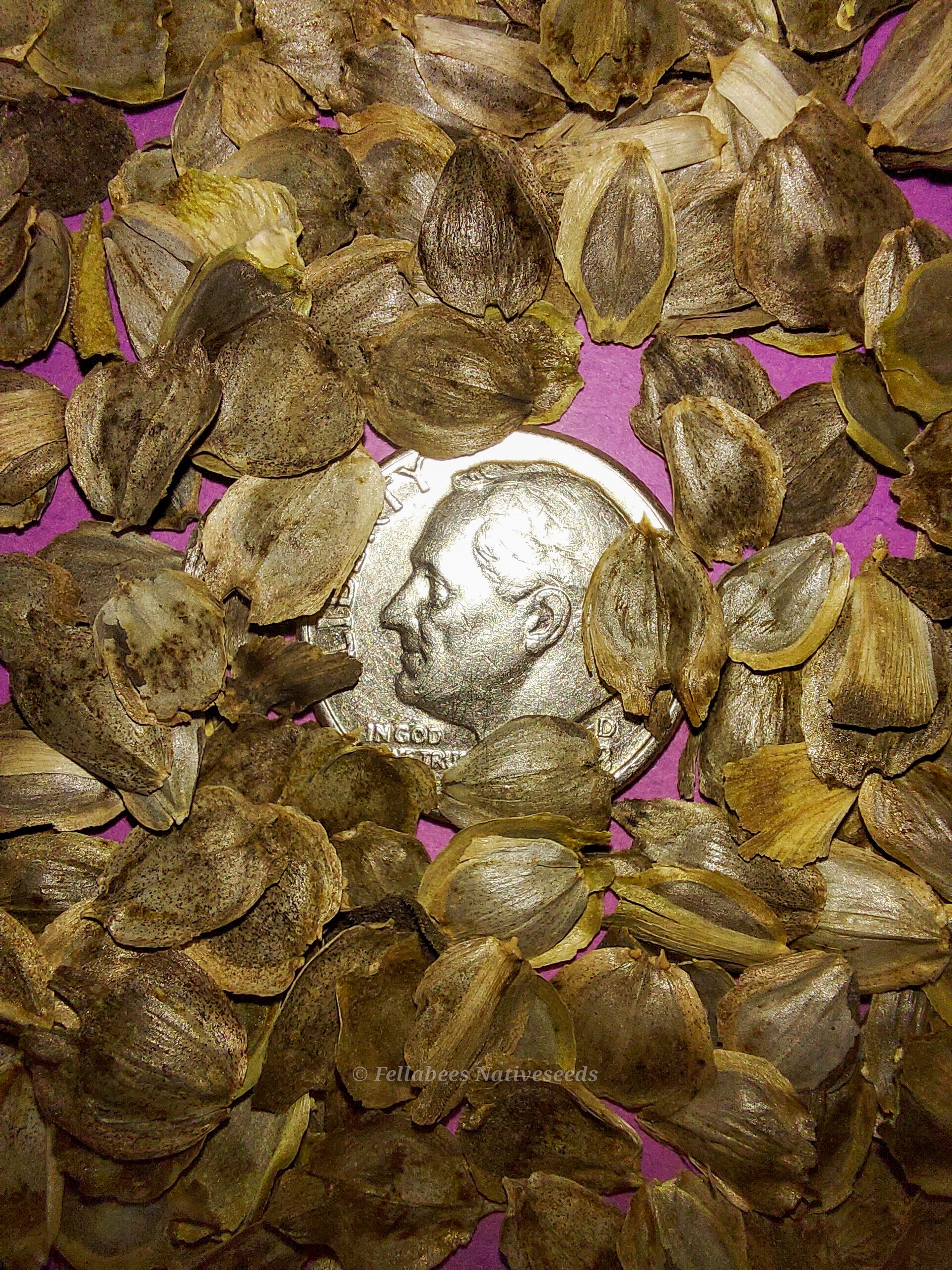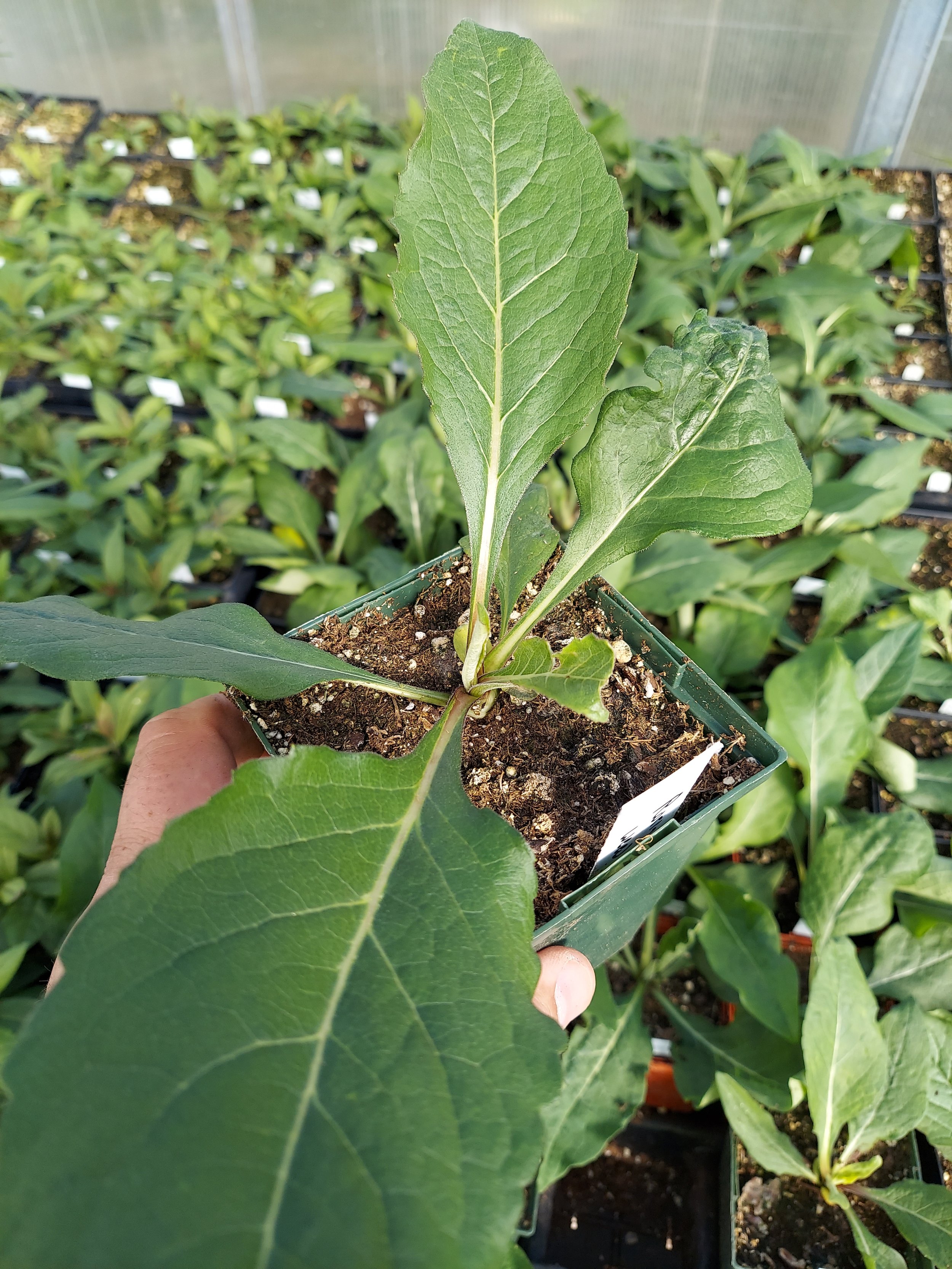 Image 1 of 4
Image 1 of 4

 Image 2 of 4
Image 2 of 4

 Image 3 of 4
Image 3 of 4

 Image 4 of 4
Image 4 of 4





Rosin Weed (Silphium integrifolium)
Rosin Weed (Silphium integrifolium)
Silphium integrifolium is a species of flowering plant in the family Asteraceae. It is also known as: rosinweed, whole-leaf rosinweed, entire-leaf rosinweed, prairie rosinweed, and silflower. It is native to eastern North America, including Ontario in Canada and the eastern and central United States as far west as New Mexico.
This species is a perennial herb growing from a fibrous root system and producing stems around 6 feet tall. It can form a large clump of up to 100 stems. The stems are hairless to slightly rough-haired, and sometimes waxy in texture. The leaves are stemless and oppositely arranged on the stems. The basal leaves are lost by maturity. The leaf blades are lance-shaped to ovate, smooth-edged or toothed, hairless to rough-haired, and up to about 9 inches in length. The inflorescence holds one to 15 flower heads. The head is lined with 2 or 3 rows of phyllaries which are hairless or rough and sometimes glandular, and have rounded bases and pointed tips. The head has up to 36 yellow ray florets and many yellow disc florets. The fruit has a short pappus.
There are two varieties of the species:
S. integifolium var. integrifolium – 1 ft 4 inches to 6 ft 7 inches in height
S. integifolium var. laeve – generally 3 ft 3 in to 4 ft 11 in tall, with more florets and hairless leaves
Plant Details
USDA Zones: 4-8
Germination Needs: 60 Days Cold Stratification
Life Cycle: Perennial
Sun Exposure: Full
Soil Moisture: Medium-Wet, Medium, Medium-Dry, Dry
Plant Spacing: 2-4 feet
Height: 5 feet
Bloom time: July, August, September
Bloom Color: Yellow
Advantages :
Pollinator Favorite: butterflies, moths, bees, wasps, beetles
Bird Favorite: seeds, insects, fruit, nectar, nesting, perchs.
Deer Resistant: Yes
Native to: Wisconsin, Minnesota, Iowa, Illinois, Indiana, Michigan, Ohio, Massachusetts, Kentucky, Tennessee, Alabama, Mississippi, Louisiana, Arkansas, Missouri, Texas, Oklahoma, Kansas, Nebraska, South Dakota, Wyoming, Colorado, and New Mexico.
This species is considered present but rare in several counties of the states of Michigan, Texas, South Dakota, and Wyoming.
This plant is considered to be extirpated (locally extinct) in one county of the state of Colorado.
.
.
Packet quantities:
We pride ourselves on ethical, hands on, ecological management, using no mechanical or chemical methods whatsoever.
All of our native seed is hand reared, hand picked, and hand packed from native prairies under our exclusive management, never breaking chain of custody from the field until it is sent to you. Each packet is hand prepared for shipment by us, directly.
Small seed species will contain greater than 20-25 seed
Large seed species will contain greater than 10-15 seed
It is our mission to spread the wealth of native plant and pollinator ecological sustainability, and educate back yard gardeners as well as corporate and government entities in how to germinate, grow, and benefit from native synergies.
Thank you for your support, it is because of you, that we can grow together to do, what we do.🐛🦋🐝🐞🌾🌱🌼🧡
Rosin Weed (Silphium integrifolium)
Silphium integrifolium is a species of flowering plant in the family Asteraceae. It is also known as: rosinweed, whole-leaf rosinweed, entire-leaf rosinweed, prairie rosinweed, and silflower. It is native to eastern North America, including Ontario in Canada and the eastern and central United States as far west as New Mexico.
This species is a perennial herb growing from a fibrous root system and producing stems around 6 feet tall. It can form a large clump of up to 100 stems. The stems are hairless to slightly rough-haired, and sometimes waxy in texture. The leaves are stemless and oppositely arranged on the stems. The basal leaves are lost by maturity. The leaf blades are lance-shaped to ovate, smooth-edged or toothed, hairless to rough-haired, and up to about 9 inches in length. The inflorescence holds one to 15 flower heads. The head is lined with 2 or 3 rows of phyllaries which are hairless or rough and sometimes glandular, and have rounded bases and pointed tips. The head has up to 36 yellow ray florets and many yellow disc florets. The fruit has a short pappus.
There are two varieties of the species:
S. integifolium var. integrifolium – 1 ft 4 inches to 6 ft 7 inches in height
S. integifolium var. laeve – generally 3 ft 3 in to 4 ft 11 in tall, with more florets and hairless leaves
Plant Details
USDA Zones: 4-8
Germination Needs: 60 Days Cold Stratification
Life Cycle: Perennial
Sun Exposure: Full
Soil Moisture: Medium-Wet, Medium, Medium-Dry, Dry
Plant Spacing: 2-4 feet
Height: 5 feet
Bloom time: July, August, September
Bloom Color: Yellow
Advantages :
Pollinator Favorite: butterflies, moths, bees, wasps, beetles
Bird Favorite: seeds, insects, fruit, nectar, nesting, perchs.
Deer Resistant: Yes
Native to: Wisconsin, Minnesota, Iowa, Illinois, Indiana, Michigan, Ohio, Massachusetts, Kentucky, Tennessee, Alabama, Mississippi, Louisiana, Arkansas, Missouri, Texas, Oklahoma, Kansas, Nebraska, South Dakota, Wyoming, Colorado, and New Mexico.
This species is considered present but rare in several counties of the states of Michigan, Texas, South Dakota, and Wyoming.
This plant is considered to be extirpated (locally extinct) in one county of the state of Colorado.
.
.
Packet quantities:
We pride ourselves on ethical, hands on, ecological management, using no mechanical or chemical methods whatsoever.
All of our native seed is hand reared, hand picked, and hand packed from native prairies under our exclusive management, never breaking chain of custody from the field until it is sent to you. Each packet is hand prepared for shipment by us, directly.
Small seed species will contain greater than 20-25 seed
Large seed species will contain greater than 10-15 seed
It is our mission to spread the wealth of native plant and pollinator ecological sustainability, and educate back yard gardeners as well as corporate and government entities in how to germinate, grow, and benefit from native synergies.
Thank you for your support, it is because of you, that we can grow together to do, what we do.🐛🦋🐝🐞🌾🌱🌼🧡
Rosin Weed (Silphium integrifolium)
Silphium integrifolium is a species of flowering plant in the family Asteraceae. It is also known as: rosinweed, whole-leaf rosinweed, entire-leaf rosinweed, prairie rosinweed, and silflower. It is native to eastern North America, including Ontario in Canada and the eastern and central United States as far west as New Mexico.
This species is a perennial herb growing from a fibrous root system and producing stems around 6 feet tall. It can form a large clump of up to 100 stems. The stems are hairless to slightly rough-haired, and sometimes waxy in texture. The leaves are stemless and oppositely arranged on the stems. The basal leaves are lost by maturity. The leaf blades are lance-shaped to ovate, smooth-edged or toothed, hairless to rough-haired, and up to about 9 inches in length. The inflorescence holds one to 15 flower heads. The head is lined with 2 or 3 rows of phyllaries which are hairless or rough and sometimes glandular, and have rounded bases and pointed tips. The head has up to 36 yellow ray florets and many yellow disc florets. The fruit has a short pappus.
There are two varieties of the species:
S. integifolium var. integrifolium – 1 ft 4 inches to 6 ft 7 inches in height
S. integifolium var. laeve – generally 3 ft 3 in to 4 ft 11 in tall, with more florets and hairless leaves
Plant Details
USDA Zones: 4-8
Germination Needs: 60 Days Cold Stratification
Life Cycle: Perennial
Sun Exposure: Full
Soil Moisture: Medium-Wet, Medium, Medium-Dry, Dry
Plant Spacing: 2-4 feet
Height: 5 feet
Bloom time: July, August, September
Bloom Color: Yellow
Advantages :
Pollinator Favorite: butterflies, moths, bees, wasps, beetles
Bird Favorite: seeds, insects, fruit, nectar, nesting, perchs.
Deer Resistant: Yes
Native to: Wisconsin, Minnesota, Iowa, Illinois, Indiana, Michigan, Ohio, Massachusetts, Kentucky, Tennessee, Alabama, Mississippi, Louisiana, Arkansas, Missouri, Texas, Oklahoma, Kansas, Nebraska, South Dakota, Wyoming, Colorado, and New Mexico.
This species is considered present but rare in several counties of the states of Michigan, Texas, South Dakota, and Wyoming.
This plant is considered to be extirpated (locally extinct) in one county of the state of Colorado.
.
.
Packet quantities:
We pride ourselves on ethical, hands on, ecological management, using no mechanical or chemical methods whatsoever.
All of our native seed is hand reared, hand picked, and hand packed from native prairies under our exclusive management, never breaking chain of custody from the field until it is sent to you. Each packet is hand prepared for shipment by us, directly.
Small seed species will contain greater than 20-25 seed
Large seed species will contain greater than 10-15 seed
It is our mission to spread the wealth of native plant and pollinator ecological sustainability, and educate back yard gardeners as well as corporate and government entities in how to germinate, grow, and benefit from native synergies.
Thank you for your support, it is because of you, that we can grow together to do, what we do.🐛🦋🐝🐞🌾🌱🌼🧡
